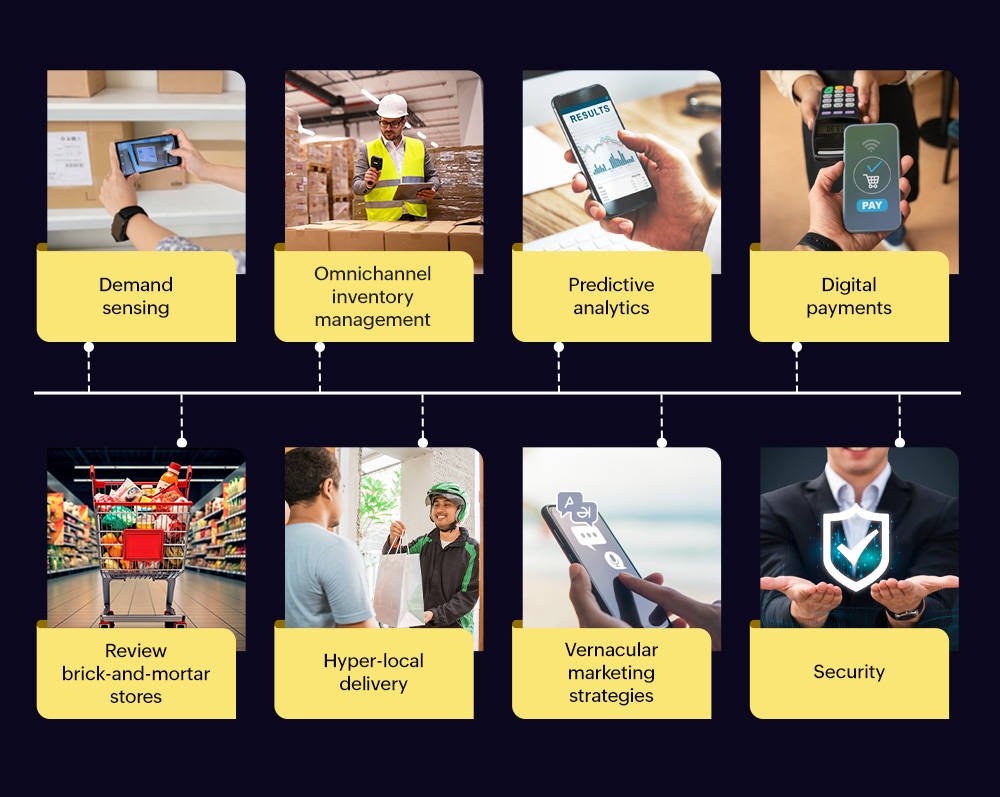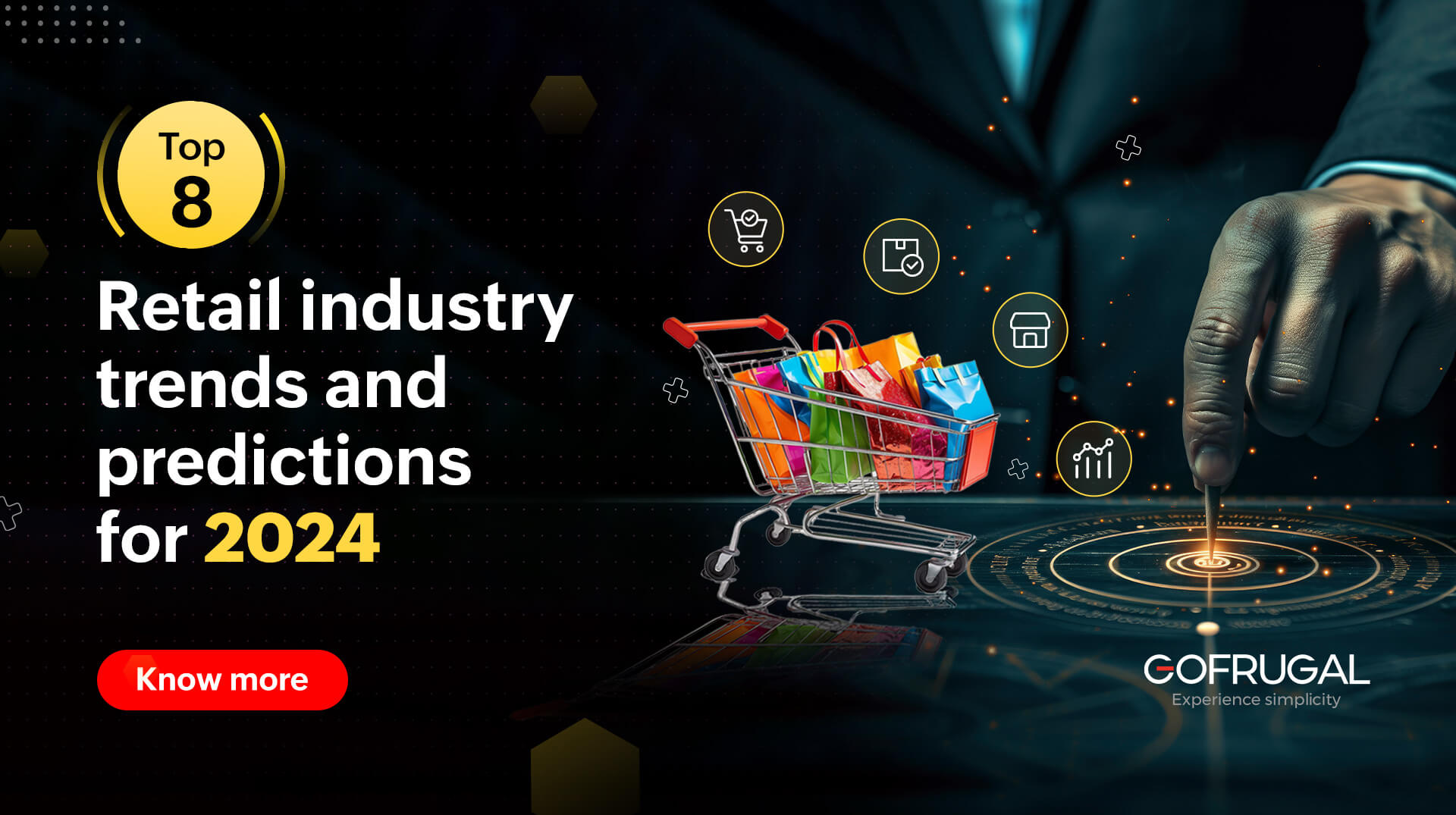Hello! This is not just any other blog on retail trends. These are the trends that you need to embrace now to reach your desired place in the retail industry.
Contents
- The importance of the retail sector in India
- 8 retail trends and predictions for 2024 in India
- Demand sensing
- Omnichannel inventory management
- Predictive analytics
- Digital payments
- Review brick-and-mortar stores
- Hyper-local delivery
- Rise of vernacular marketing strategies in 2024
- Security
The importance of the retail sector in India
The retail sector in India contributes 10% of the GDP, and the potential of the retail sector is promising, with an estimation to reach a valuation of $2 trillion by the end of 2032.
For a frame of reference to help you conceptualize these numbers better, the Indian retail sector turns out to be the 11th largest economy in the world, superseding nations like Russia, South Korea, Australia, and Spain, among others.
The explosive growth of India's retail sector can be attributed to the following factors.
- Expansion of urban centers: Cities like Coimbatore, Nagpur, Lucknow, and Patna, among others, are experiencing rapid urbanization. This demographic shift is amplifying the spending potential of the Indian middle class, creating new opportunities for retailers.
- Mobile network penetration: With 77% of Indians now connected via mobile devices, there's a profound impact on consumer behavior. The widespread accessibility of mobile networks is reshaping how consumers interact with brands, influencing their purchasing decisions, and driving the need for innovative retail solutions.
- Empowered Gen Z and millennial cohorts: The rising spending capacity of Gen Z and millennials is reshaping retail dynamics. These digitally-savvy consumers demand personalized experiences, convenience, and sustainability from retailers, driving the adoption of new business models and technologies.
- Integration of new technologies: The retail sector is embracing innovative technologies to enhance customer experiences and streamline operations. From AI-driven analytics to augmented reality shopping experiences, the application of cutting-edge technologies is revolutionizing the way retailers engage with consumers and manage their businesses.
8 retail trends and predictions for 2024 in India

Demand sensing
Inventory management is important and nonnegotiable. That's why demand sensing is a significant retail industry trend bringing focus to this pivotal facet of inventory management. With real-time data analytics, businesses have to accurately comprehend and interpret the fluid nature of customer demand.
Anticipate shifts in customer preferences. Draw insights from different sources, such as social media trends, economic indicators, and sentiment analysis. Pull-up reports from your POS software help you with in-depth BI POS companies to get a comprehensive understanding of market dynamics. With this knowledge, it is easier to fine-tune inventory levels and distribution strategies.
With the nature of the current volatile market, this is a necessity. Traditional forecasting models fall short of capturing sudden shifts in consumer behavior, but with demand sensing, optimizing inventory levels, mitigating the risk of stockouts, and seizing nascent opportunities are guaranteed.
Omnichannel inventory management
Retailers embracing omnichannel strategies find it easier to integrate multiple channels to optimize customer interactions across every touchpoint of the shopping journey. From the initial engagement to product discovery, fostering purchase intent, and finally completing the transaction, an omnichannel approach ensures a smooth and effortless buying experience for customers.
For instance, the marketing team of a direct-to-consumer (D2C) brand can leverage insights into customers' shopping behaviors to offer personalized product recommendations tailored to their preferences. Moreover, by directing customers to physical retail outlets, popular brands have witnessed a notable 45% increase in conversion rates, emphasizing the effectiveness of omnichannel strategies in driving sales.
Omnichannel strategies help make inventory management efficient, optimizing data utilization costs, and deploying cost-effective marketing initiatives. Adopting this retail trend not only fosters customer loyalty but also translates into tangible benefits such as increased foot traffic, enhanced profitability, and deeper customer engagement.
Predictive analytics
In just four years, procurement digitalization has surged from 21% to a significant high, fueled by the adoption of strategic sourcing, predictive analytics, and supplier collaboration tools. Reliance on digital procurement automation tools has become imperative, rendering traditional methods obsolete.
Across industries, organizations are embracing digital tools for sourcing, contract management, vendor relationships, and payments, recognizing the need to streamline processes and stay agile in an increasingly digital landscape. Invest in the latest AI-ML-based autonomous tool to make efficient purchases and inter-store transfers with almost no human resources but with the highest accuracy, ensuring reduced investment by utilizing the on-hand inventory effectively. Stop worrying about purchase management and focus on expanding your business to get better margins.
Digital payments
Many individuals in India have embraced mobile wallets linked to their bank accounts as their primary mode of financial transactions, gradually moving away from the use of hard currency or traditional debit or credit cards. From everyday expenses like auto fares to larger purchases such as groceries, mobile wallets have spearheaded a transformative shift in spending habits. Notably, Indians have accounted for a substantial 46% of the total global real-time transactions, a figure poised for further growth.
The landscape of digital payments in India is evolving, with Tier 2 and Tier 3 cities emerging as pivotal hubs for expansion. In the past two years alone, these cities have contributed to a significant 60–70% of new clientele. The impending proliferation of 5G networks in rural areas is expected to catalyze the adoption of digital payments even further, with projections indicating that upwards of 90% of all retail transactions will be conducted digitally in the foreseeable future.
Moreover, the advent of Buy Now, Pay Later (BNPL) services has witnessed remarkable uptake, with a notable 41% of survey respondents having utilized such services. So, it is important for your business and the software you invest in to offer multiple payment options and also support different payment integrations.
Review brick-and-mortar stores
The landscape of retail has evolved significantly over the years, with online-only stores once reigning supreme. However, the current reality reveals that online-only retail models often struggle to turn a profit due to a multitude of factors.
Returns pose a significant challenge for online apparel retailers, with around 50% of items being returned on average. Processing returns entail additional workforce and resources, including repackaging items and coordinating with manufacturers or primary producers, all of which erode profitability.
Moreover, meeting consumer expectations for speedy deliveries, often within the same day or two to three business days, necessitates a robust logistics network supported by costly fulfillment centers. In contrast, brick-and-mortar stores have the advantage of utilizing their physical space for product storage, eliminating the need for separate warehouses. Notably, showcasing products in-store can significantly boost sales by up to 110%, with the added benefit of offering Buy Online, Pick Up in Store (BOPIS) options, which can lead to a 40% increase in sales as customers tend to make additional purchases when collecting their orders.
Recognizing the symbiotic relationship between online and physical retail, the International Council of Shopping Centers conducted a comprehensive survey, revealing an average increase of 6.9% in a brand's online traffic following the opening of a physical store. So, it is important to pay attention to your physical store as much as you pay attention to your online website.
Make your store layout easily accessible to all. Leverage the benefits of rack management features and customer shopping patterns to procure, arrange, and bundle in-store offers and display products accordingly in your store.
Hyper-local delivery
One of the major retail trends in 2024 that will still continue to rule is hyper-local delivery. Everyone wants everything delivered to their doorstep. In India, there's been a notable surge in companies offering swift and precise delivery services. The delivery goal of 10 minutes has emerged as the benchmark, reflecting a brand's prowess in both technical capabilities and logistical efficiency.
To harness the power of the Indian quick commerce market, it is important to harness cutting-edge technological advancements to streamline delivery processes and slash delivery times. One such innovation is retail location analytics, which plays a pivotal role in enhancing the end-customer experience. With this, companies can construct micro-warehouses or urban fulfillment centers. These micro-warehouses, smaller in size compared to their traditional counterparts, leverage location data to identify sites that not only meet operational requirements but also offer cost-effective rental options, thereby making hyper-local delivery both economically viable and seamless.
Initiatives like ONDC and the Open Network for Digital Commerce help businesses go online and achieve hyper-local delivery with the least investment. Embracing the retail trend of hyper-local delivery creates a huge impact on businesses.
Rise of vernacular marketing strategies in 2024
Only 10% of Indians are comfortable speaking English. This fact underscores the importance of adopting vernacular marketing strategies to effectively reach diverse target audiences across India. Brands like Amul and national newspapers have already embraced this approach by running vernacular content, expanding their reach, and tapping into previously undeveloped markets.
By providing content in familiar vernaculars, these platforms enhance users' understanding of products, resulting in increased repeat purchases. The introduction of a vernacular search feature further demonstrates the industry's recognition of the importance of catering to diverse linguistic preferences. With over 25% of ecommerce users utilizing vernacular voice services for product searches in 2022, the adoption of such services is expected to rise in the coming years.
In 2024, pan-Indian retail ecommerce brands are acknowledging the effectiveness of vernacular marketing strategies in tailoring models to meet the unique needs of Indian consumers. You can also let your employees use their billing software menus in their preferred regional language, extending this retail trend to make billing more comfortable. You can also print bills in languages customers prefer.
Security
Security is one retail trend that is never outdated. Whether it's crafting user personas for enhanced customer experiences or maintaining up-to-date inventory records, data underpins the seamless operations of modern retail across physical, ecommerce, and omnichannel platforms.
Unfortunately, this reliance on data also makes retailers prime targets for malicious cyberattacks, with ransomware attacks posing a significant threat. These attacks often involve encrypting sensitive personal data, causing disruptions to business operations across subsidiaries.
According to a Sophos survey on the state of ransomware in retail, a mere 26% of retailers were successful in thwarting ransomware attackers from breaching their defenses. Alarmingly, over 43% of retail victims opted to pay the ransom, underscoring the lucrative nature of the retail sector for cybercriminals. However, there has been a slight uptick in the percentage of businesses recovering from such attacks, rising from 17% to 21% in the past year. This suggests a concerning trend of increasing sophistication in ransomware tactics and encryption methods employed by hackers.
In response to these threats, retailers have to proactively invest in robust security management software and leveraging cloud-based data storage for swift data recovery. Key considerations include ensuring comprehensive audit trails within software solutions and evaluating security management features that support various authentication methods and role-based access, thus instilling confidence in the safety of critical data assets.
One important trend you can embrace right away is adopting the right digital technology to grow your business or evaluate if you are already using the right digital technology. In 2024, Indian retail is poised for unprecedented growth. Navigating this dynamic landscape requires a nuanced understanding of emerging trends and strategic partnerships with digital technology providers. Stakeholders must leverage data analytics, omnichannel strategies, and robust cybersecurity measures to ensure resilience and relevance in the evolving retail environment. Want to know how? Talk to us today!
Source: IBEF, Indian retailer, Geo IQ, Statista, Hootsuite, Hubspot, Deloitte

